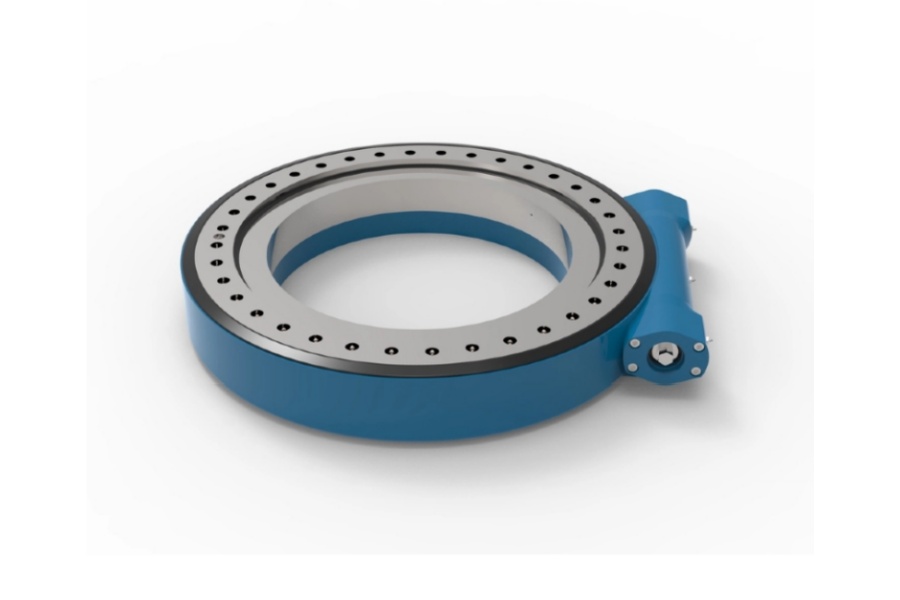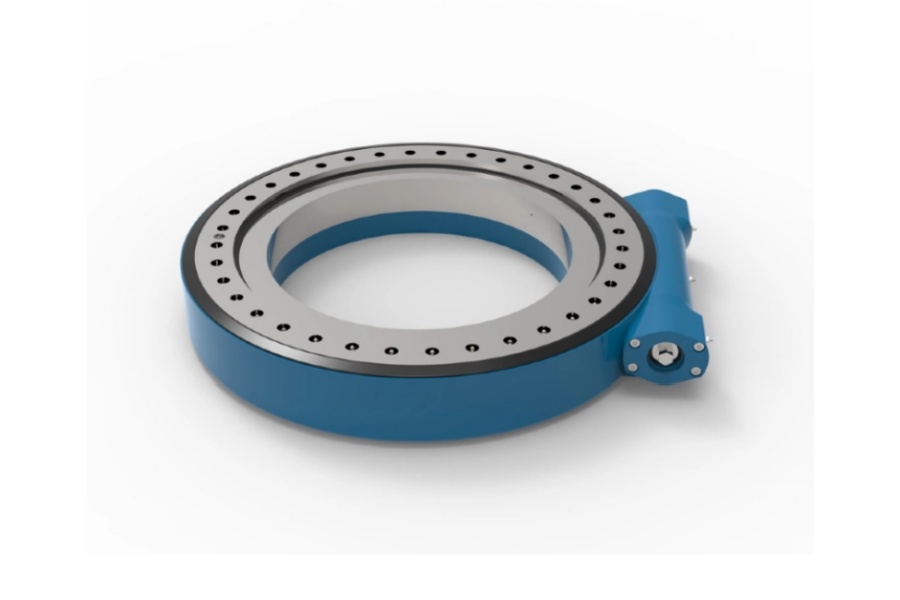
Slew Drive Oil Lubrication vs Grease Lubrication Differences
What is a Slew Drive
A Slew Drive is an integrated mechanical assembly that combines a slewing ring bearing with a worm gear reduction mechanism into a single compact unit designed to facilitate controlled rotational movement while supporting substantial combined loads. This system efficiently transmits high torque from a compact motor source while handling axial, radial, and moment loads simultaneously. The precision-engineered interface between the worm gear and the main gear ring requires proper lubrication to minimize friction, reduce wear, dissipate heat, and prevent corrosion. The selection of appropriate lubrication method significantly impacts the drive's performance, maintenance requirements, service life, and operational efficiency across various environmental conditions and application demands.

Differences Between Oil and Grease Lubrication
The choice between oil and grease lubrication represents a critical design consideration that affects nearly aspect of slew drive performance. Oil lubrication provides superior heat transfer capabilities, making it particularly advantageous for high-speed, heavy-load, and high-temperature applications. The fluid nature of oil enables efficient circulation throughout the gear mesh and bearing surfaces, carrying away heat generated by friction and ensuring consistent temperature distribution across components. This cooling effect helps maintain optimal operating temperatures, preserves lubricant properties, and reduces thermal stress on components. Oil systems typically offer better contamination control through filtration systems that can remove particulate matter and degradation products from the lubricant, thereby extending component life. The flow characteristics of oil facilitate more effective penetration into precise gear meshes and bearing interfaces, ensuring complete lubrication of all critical surfaces. However, oil lubrication requires more complex sealing systems to prevent leakage, regular monitoring of lubricant condition, and more sophisticated maintenance procedures compared to grease systems.
Grease lubrication offers simplicity and convenience that makes it suitable for numerous industrial applications. This lubrication method utilizes a semi-solid lubricant consisting of oil suspended in a thickener base, which remains in place and provides continuous lubrication without requiring complex circulation systems. The adhesive properties of grease enable it to maintain a protective film on metal surfaces, reducing friction and wear even in applications with intermittent operation or prolonged stationary periods. Grease lubrication systems typically require less maintenance intervention than oil systems, with longer relubrication intervals that reduce downtime and maintenance costs. The sealed nature of grease lubrication helps exclude contaminants from critical components, providing enhanced protection in dusty or dirty operating environments. However, grease has limited heat transfer capabilities and cannot effectively dissipate heat generated by continuous high-speed operation or heavy loads. This limitation makes grease unsuitable for applications requiring significant cooling or those operating at extreme temperatures. Grease also exhibits higher resistance to movement at startup in cold temperatures, potentially increasing starting torque requirements.
The performance characteristics of each lubrication method vary significantly under different operational conditions. Oil lubrication maintains more consistent viscosity and lubrication properties across a wide temperature range when properly selected, though it requires viscosity grading appropriate for expected operating temperatures. Modern synthetic oils can provide exceptional performance in extreme temperatures and demanding conditions, though at higher cost than mineral-based alternatives. Grease consistency varies considerably with temperature changes, becoming softer at high temperatures and stiffer in cold conditions, which affects its ability to lubricate effectively. The dropping point of grease—the temperature at which it transitions from semi-solid to liquid—determines its maximum usable temperature range. For cold weather applications, low-temperature greases with appropriate consistency must be selected to ensure proper lubrication.
Maintenance requirements differ substantially between the two lubrication methods. Oil lubrication systems typically require periodic oil analysis to monitor lubricant condition, contamination levels, and additive depletion. Oil changes involve complete draining and replacement of lubricant, which can be time-consuming and require proper disposal of used oil. Filtration systems need regular maintenance to ensure proper contaminant removal. Grease lubrication involves simpler replenishment procedures, though proper purging of old grease is essential to prevent additive depletion and contamination buildup. Grease lubrication often requires more frequent application in high-load applications but generally involves less complex maintenance procedures overall.
Environmental considerations also influence lubrication selection. Oil leakage can create environmental hazards, require containment measures, and potentially damage surrounding equipment or products. Modern synthetic biodegradable oils address some environmental concerns but at higher cost. Grease generally poses less environmental risk from leakage due to its semi-solid nature, though proper disposal practices must still be followed. Both lubrication types have evolved with advanced additive packages that enhance performance characteristics. Extreme pressure (EP) additives, anti-wear agents, rust inhibitors, and oxidation stabilizers improve performance in both oils and greases, though specific additive formulations differ between the two lubrication types.
Key Characteristics of Slew Drives
Slew drives possess distinctive characteristics that make them valuable across numerous applications. Their high torque density enables compact design solutions capable of delivering substantial rotational force from relatively small package dimensions. The integrated design philosophy combines multiple functional elements including bearing support, gear reduction, and mounting structure into a single sealed unit that reduces assembly complexity while improving overall system reliability. Precision positioning capability varies among different quality tiers, with high-performance units offering excellent positional accuracy and repeatability. The inherent self-locking capability of the worm gear design provides built-in load holding without requiring additional braking systems, enhancing safety while simplifying control requirements. Robust construction enables reliable operation in demanding industrial environments, with various sealing options available for contaminated or washdown conditions. Flexible configuration possibilities include various mounting orientations, drive motor interfaces, and feedback system integrations that facilitate adaptation to specific application requirements. The high stiffness of properly manufactured units ensures minimal deflection under load, maintaining precision even when handling substantial off-center loads.
Broader Applications of Slew Drives
Slew drives serve critical functions across multiple industries with varying lubrication requirements. The renewable energy sector employs these drives in solar tracking systems where they precisely position photovoltaic panels, requiring lubrication that can withstand environmental exposure and temperature variations. Construction equipment relies on slew drives for excavator upper structure rotation, crane boom positioning, and concrete pump operation where robust lubrication must handle extreme loads and contaminated environments. Wind energy applications utilize these components in yaw control systems that orient nacelles and pitch control systems that adjust blade angle, requiring reliable lubrication for maintenance-free operation in inaccessible locations. The aerospace and defense sectors incorporate precision slew drives in radar antenna positioning, satellite communication systems, and weapon station aiming mechanisms that demand exceptional reliability with minimal maintenance. Marine and offshore applications include deck crane rotation, winch positioning, and equipment handling systems built to withstand corrosive saltwater environments with appropriate corrosion-inhibiting lubrication. Medical equipment manufacturers use specially engineered slew drives in CT scanner gantries, surgical robot positioning, and patient table adjustment mechanisms requiring clean, quiet operation with specific lubrication compatibility. Transportation systems incorporate these drives in vehicle turntables, maintenance positioners, and material handling equipment that must operate with high reliability while withstanding vibration and environmental challenges.
Factors Influencing Slew Drive Pricing
The pricing of slew drives is determined by multiple engineering and commercial considerations that significantly affect their performance characteristics and lubrication requirements. Material selection profoundly impacts cost, with standard carbon steel constructions representing the most economical option while premium alloy steels and specialized coatings necessary for extreme conditions command substantially higher pricing. Precision engineering requirements represent a major cost factor, as achieving and maintaining tight tolerances necessitates advanced manufacturing equipment, specialized processes, and comprehensive quality control measures. Load capacity requirements directly influence price through material requirements, bearing size, and structural design complexity. Performance specifications for accuracy, efficiency, and operational life significantly affect manufacturing processes and associated costs. Drive size and scale determine material volume requirements and manufacturing complexity, with larger diameter units requiring specialized processing equipment. Lubrication system complexity affects pricing, with oil lubrication systems typically costing more than grease systems due to additional components and sealing requirements. Sealing and protection requirements for specific environmental conditions add components and assembly complexity that increase price. Ancillary components such as integrated encoders, brakes, and special lubrication systems represent additional cost factors beyond the basic drive unit. Custom engineering for unique mounting configurations, special interface requirements, or application-specific modifications requires non-recurring engineering costs that significantly affect pricing. Production volume dramatically influences unit cost through manufacturing efficiencies, with high-volume orders benefiting from economies of scale. Quality certification requirements for specific industries necessitate additional testing, documentation, and quality assurance processes that contribute to overall cost while ensuring performance consistency.
Supplier of Slew Drive
LYRADRIVE has established itself as a proficient manufacturer and global supplier of high-performance slew drives for various industrial applications. The company's product range encompasses both standard catalog designs and custom-engineered solutions tailored to specific operational requirements and lubrication needs. Their technical expertise focuses on delivering drives with optimized performance characteristics, reliable operation under various conditions, and configurations that integrate seamlessly with different equipment types. LYRADRIVE provides comprehensive engineering support to help customers select appropriate drive configurations based on specific load, environmental, and performance requirements. The company's manufacturing capabilities include advanced quality control processes to ensure consistent performance characteristics essential for reliable operation. For engineers and equipment manufacturers seeking rotational motion solutions with appropriate lubrication systems, LYRADRIVE offers technically capable products supported by application expertise and engineering consultation services.



